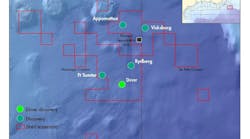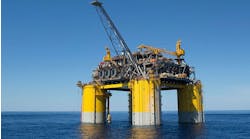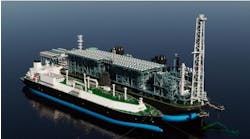Drilling menace giving way to foam, fast-setting cement technologies
Rick Von Flatern
Technology Editor
When operators first entered the deep waters (more than 2,000-ft) of the Gulf of Mexico, they were surprised by the presence of unconsolidated sands between 300 ft and 5,000 ft below the mudline. These highly permeable sands are widely referred to as shallow water flows because they are sufficiently geopressured to force water and sand into the lower pressured well bores. First reported by Shell Offshore in the Gulf of Mexico, such flows since have been reported in deepwater offshore West Africa, Southeast Asia, and west of the Shetland Islands.
Failure to control these shallow water flows can have catastrophic consequences. Gone unchecked, the cost to operators can range from $100,000 squeeze jobs to total loss of the wellbore and millions of investment dollars.
Their presence came as a surprise to deepwater pioneers because traditional seismic data processing, aimed at locating possible hydrocarbon-bearing formations, does not detail shallow the geology at such shallow depths. Since then, knowing what to look for, shallow water flow formations have been mapped by integrating 2D seismic with 3D databases and offset data. Operators can then drill around the formations or pick locations which will result in wellpaths through their thinnest sections.
Challenges
The defining characteristic of shallow water flow formations is a thin margin between the fracture gradient and pore pressure. As a result, operators approach them much as they would potential lost circulation zones; with casing set to the formation top so it can be drilled with reduced drilling fluid density.The procedure, while generally effective, has the same drawbacks as does other unexpected, abnormally-pressured zones. For example, typical Gulf of Mexico casing designs must be altered to include an otherwise unnecessary intermediate casing string. And in many cases riserless drilling is no longer an option once the extra string is run. The resulting cost in casing, cement, and time (particularly chafing in these days of rapidly escalating dayrates) is significant and almost always results in a casing size reduction from the optimum well design.
Knowing the offending zone is present is no guarantee against its causing drilling problems. Once the casing above the zone is set, drilling ahead, especially in extended sections, has been difficult and setting and cementing casing across the unconsolidated sands often expensive and technically problematic. Just as with the fluids to drill through them, cement slurries must be precariously balanced between fracture and containment when being pumped into place - a problem compounded by the chemistry of cement.
Transition time dangers
When cement sets, it passes from a liquid slurry, over time, to a state of hardness measured in compressive strength. During this transition time, before it reaches any measurable compressive strength, the cement exists as a gel, accompanied by loss of volume and hydrostatic pressure against the formation.The cement hardening process is further complicated by the thermal history cement slurries must endure between the surface and their final destination in deep and ultradeep water operations. The mixing process raises the cement to about 95 degrees F. It is then pumped through 2,000-3,000 ft of water that at the seafloor is within a few degrees of freezing. Finally, after it passes the seafloor and travels through the casing and casing-open hole annulus, the earth's natural thermal gradient warms the slurry about 10 degrees F.
In such cases, the temperatures are sufficiently low to severely extend cement transition time. In simple cold environments, the consequence, while not desirable, is simply prolonged wait-on-cement times and possibly casing shoe squeeze jobs. But in the presence of a geopressured formation, the entire cement job can be lost to water (and sand) influx during the extended time of low hydrostatic pressure.
Better cements
The goal of cementers then has been to either reduce the effects of cold on cement transition time, extend transition times on hydrostatic pressure, or both. Invoking lost circulation and reduced pore pressure zone strategies, joint industry investigations have most often led experts to look to lightweight cements, particularly nitrogen foamed cements.Nitrogen has been mixed into cement slurries onshore for many years to create low density cements for placement across depleted or underpressured, high permeability zones. The gas, injected into the slurry as it is being pumped, reduces cement density without reducing the set cement's ultimate compressive strength.
But until the discovery of shallow water flows in deepwater, the cost and logistic difficulties of nitrogen slurry injection was prohibitive offshore. Onshore, nitrogen injection equipment was modeled on that used in nitrogen hydraulic fracturing, too large a scale for offshore applications.
But the financial consequences of uncontrolled shallow water flows along with the proven benefits of foam to the problem at hand, have convinced cementing and operating companies to overcome the logistical hurdles. Nitrogen mixing units have been scaled down to fit the space restrictions of offshore platforms. The equipment has also been safety engineered and metered for the much lower flow rates of cement foaming.
Besides the benefits of using low density cement against unconsolidated formations, nitrogen imbues cement with the other major physical characteristics of all gases - compressibility and expandability. This means that during the cement's transition stage during which hydrostatic pressure normally degrades, the entrained gas expands, counteracting most gelling effects.
Nitrogen expansion
"The idea is the same as gas influx," said Schlumberger's Leo Burdylo. "If it doesn't set up fast, gas flows in. Foam is the most efficient way to get 12.5 ppg cement." Burdylo and other industry cementing experts report nitrogen foamed cement setting times to be around 30 minutes from the time they are in place. And, according to Halliburton's Ronnie Faul, low temperatures seem not to affect their ability to get the job done."The temperatures of the Baja prospects were 36-38 degrees F at bottom - not so different from 4,000 ft of water," Faul said. "Even at that temperature foam has performed best. That is what was used in 7,600 ft of water at the Baja Prospect."
Speaking at a deepwater technology conference in New Orleans, Faul emphasized that good cementing procedures were crucial to optimizing foams' effects on water containment and zonal isolation. His recommendations included a 13-15 ppg sweep fluid foamed to 8-11 ppg, a control settable spotting fluid, Halliburton's foamed cement slurry, and tail slurries.
Besides cost and space requirements, difficulty coordinating nitrogen injection and slurry rates to keep a consistent density also made operators shy of foamed cements. But, say both Faul and Burdylo, computer software specifically designed for that purpose has recently been developed and proved.
Burdylo believes that while foam adds 10-20% cost to cementing operations, it is easily absorbed when contrasted to the savings realized avoiding the possibly catastrophic effects of shallow water flows. Burdylo's argument is made more persuasive when viewed against the immense expenditures that characterize deep and ultradeep water operations.
Cold conditions
On another tack, BJ Service's cementing research and develop section leader, Dan Mueller, is investigating base cement performance as a key to deepwater cementing. He believes operators are currently focused on shallow water flows because of the possible catastrophic ramifications of failures and that they would be better served concentrating on the effects of low temperatures on the early gel and compressive of the base cement. "Water flow is a hot topic because it is very visible," he said. "Every well is going to face this (low temperature environment) and as we get deeper it is only going to get worse."The BJ laboratory in Tomball, Texas has refrigerated cement testing and much of the work centers around gypsum-portland cement blends similar to those run in the permafrost areas of Alaska and Siberia. The advantage to these types of cements, Mueller and others in the BJ Tomball R&D group contend, is their ability to achieve early compressive strength at 45-55 degrees F while imparting the necessary gel strength properties to control water flow. At temperatures below 60 degrees F, "the hydraulic activity of the Portland cement declines rapidly," Mueller said. "As the reaction slows, the rate of gel strength buildup, and ultimately compressive strength, is delayed."
For example, when mixed at ambient temperatures but cured at 55 degrees F, a typical 15.6 ppg Class A cement accelerated with calcium chloride will require 10-12 hours to achieve 50 psi compressive strength. According to Mueller, it is during this period that the cement sheath is susceptible to fluid infiltration.
"When evaluating designs for cementing conductor-surface casing in deepwater, we must simulate, as closely as possible, the specific therrmal environment in which the cement will be placed," Mueller said. BJ Service's models have shown dramatically slowed reactivity in conventional portland cements at the seafloor and so have switched their focus to portland-gypsum blends.
Mueller and his colleagues have reconstructed in their laboratory the unique thermal environments encountered while pumping in deep water. Their goal is to shorten gypsum-portland blend cement strength development times to reduce the opportunity for shallow water flow, promoting the early compressive strength development while allowing sufficient pump time. Currently, they are optimizing the cement-accelerator ratio to decrease the transition time from 100 to 500 lb/100 sq ft gel strength. Once the cement is placed, Mueller is aiming at about 20 minutes to gain a compressive strength capable of restraining water influx from shallow water flow zones.
Formation consolidation
William Bennet and Victor Dunayevsky of Westport Technology Center International in Houston, are attacking shallow water flows on another front. They have succeeded recently in developing a computer code for, as their project is named, a "fluid placement model for permeability impairment of shallow water flows."The software program uses borehole diameter, injection target sand vertical thickness, bottomhole injection pressure, and layer porosity and permeability. Or, since the geology of deepwater is mostly uncharted, as much of that information as is available. "A lot of these are obviously going to be best estimates," Bennet said. "But hopefully they will have some of them."
The program will calculate how to place a formation consolidating fluid into the formation to shut off permeability. Output includes the time and maximum pump pressure to place the fluid the optimum distance from the wellbore.
The model assumes a clear, time-activated monomer fluid rather than the more familiar polymer gels common to water shut-off and conformance technology practices. "Our model showed that any substantial viscosity above a few centipoise would slow the process or you'd start hitting fracture initiation."
As in the case of foams, formation gel treatments are not cheap. Conformance treatments will be done to about a five-ft radius from wellbore. And some of the target formations are hundreds of ft in length. But also like foams, the cost is a trade off and must be seen in terms of alternatives. Not only is formation consolidation a way to ward off catastrophic water influx to the wellbore, it could also save operators the cost of a casing string and early abandonment of riserless drilling.'
Copyright 1997 Offshore. All Rights Reserved.


